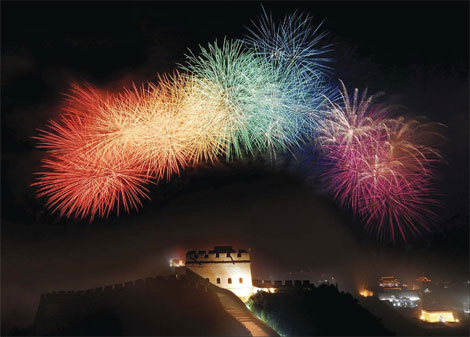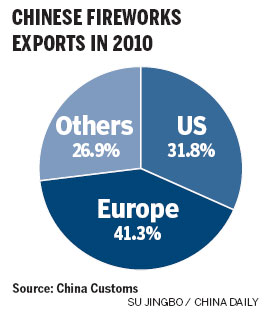Shining through
Updated: 2011-07-01 13:17
By Xiao Xiangyi and Feng Zhiwei (China Daily European Weekly)
|
 Fireworks lighten up the Great Wall. Some Chinese fireworks produce no odor or smoke and are becoming more environment-friendly. Provided to China Daily |
Chinese fireworks overcome cloudy times, pin hopes on burgeoning domestic demand
Chinese fireworks makers are bouncing back in overseas markets after breakthroughs in port logistics bottlenecks. July and August are peak seasons for delivering Chinese fireworks. In Liuyang, known as the "cradle of fireworks" in Hunan province, long lines of trucks flashing hazard warning signs form outside factories, ready to transport crates of pyrotechnics to Shanghai port 1,200 kilometers away.
The fireworks are shipped to Hamburg, Germany, and arrive a month later to delight audiences at European celebrations and festivals.
Exports of Chinese fireworks reached $557 million (60 million euros) in 2009 and $553 million last year, according to Chinese customs statistics.
Hunan fireworks makers provide more than 57 percent of the exports, according to International Fireworks Association (IFA). The European market has long been importing Chinese fireworks. More than 40 percent of Chinese fireworks exports went to Europe and 31.8 percent of exports went to the United States. Chinese fireworks exports were the highest in 2009 and last year, figures from the IFA show.
China, which has been making 90 percent of the fireworks sold worldwide for the past 20 years, witnessed a slow down in its fireworks industry in 2008.
Purchasing power in Europe and the US also decreased during the recession."But this was not devastating to our exports, customers just chose to buy less instead of not buying at all," says Liu Donghui, secretary-general of the IFA.
In February 2008, a fireworks warehouse explosion led to a ban on fireworks shipments at Guangdong province's Sanshui port, which was then China's most important fireworks exporting port. Later in June, Shanghai port was also banned from shipping fireworks out of safety concerns for the Beijing Olympic Games. These had huge ripple effects for both Chinese production backlogs and foreign retailers.
But as the government strengthened safety supervision of the fireworks industry in segments such as production, transport and storage, more ports have opened for fireworks. For the past two years, more orders from overseas mean that the Chinese fireworks industry is recovering from the export crisis.
|
 |
Shanghai has replaced Sanshui as the biggest exporting port for fireworks, with 70 percent of Chinese pyrotechnics being shipped from there, says the IFA. Beihai port in the Guangxi Zhuang autonomous region, with about 15 percent of the share, is the second largest. Wuzhou in Guangxi and Lianyungang port in Jiangsu province are also receiving fireworks for export.
"The opening of Wuzhou port in May 2011 actually means a lot, as it is close to Hong Kong, which is another distributing center for fireworks. The distance between Liuyang and Wuzhou is only 800 kilometers, which is 400 kilometers less than that between Liuyang and Beihai," Liu says.
"It was indeed tough in 2008 when shipping of the goods was almost stopped. The shipping price for fireworks was four times more than for ordinary goods. Now we don't have this problem, although shipping is still expensive," says Andreas Voigt, chief of research and development at the German Blackbox Fireworks Company.
"Now things are getting much better. Limitations of ports and containers are no longer the biggest challenges in our exports," says Zhong Ziqi, president of Dancing Fireworks Group based in Liuyang, one of the biggest fireworks exporters in China. The group exported 5,000 cartons of fireworks to Europe in 2008 but the exports rocketed to 23,000 cartons in 2009 and 28,000 cartons last year.
But limitations and regulations still exist, companies say. Since 2007, fireworks headed for the European market have had to meet a CE standard, which includes the weight of powder ingredients used in the items.
"The CE standard is not hard to meet, but the testing procedures are complicated and the testing cost is high. Some small companies might feel the pressure," Liu says.
"There are only seven or eight authorities who can issue the CE certificates, and the process is slow and complex, " says Zhong Juan, general manager of Dongyang Trading Company, which is a branch of Dancing Group.
"Actually, new Chinese standards for fireworks is even higher than the European ones," says Huang Qichang, president of Qingtai Fireworks Company.
But the constant price hike of raw materials and labor shortage are making Chinese manufacturers feel the pinch.
"We have had to employ workers from other provinces and pay them at least 20 percent higher salaries since this Spring Festival," Zhong says.
"The shortage of labor is really a big problem. Liuyang's development is so amazing over the past few years. Every household might have at least one car," says Heino Roos, chief representative and quality control manager of Keller Company, a German retailer which has been trading fireworks for more than 40 years.
"Workers' salaries are not so good and I saw only elderly people working in the fireworks factories, that means youngsters are not willing to do that anymore."
"The cost of raw materials are rising dramatically and transport costs also influence us a lot," Roos says.
"Shipping costs for containers holding dangerous goods from Shanghai to Hamburg is also rocketing."
The top three shipping companies handling Chinese fireworks exports are Chinese Cosco, China Shipping and Danish Maersk, the IFA says.
"In Germany we have a low price market for fireworks. Perhaps once a year, each family would spend 50 to 100 euros on fireworks," Roos says.
Huang Qichang, president of Qingtai, says that in spite of the rising costs of labor and raw materials, and even the appreciation of the yuan, sales revenue for his company's exports of Qingtai is still increasing in these two years.
"Chinese manufacturers are still willing to export even though the profit is lower than the sales in the domestic market, because they can get paid on time because of foreign companies' honesty and trustworthiness," says Liu of IFA.
At Dancing Company, exports make up 50 percent of its business.
"Since the US has long been our biggest market, we are going to expand our sales in the European market which holds much potential," Zhong Ziqi says.
Beijing ended its 10-year ban on fireworks during Spring Festival in 2006. Many other major Chinese cities also changed their attitude toward fireworks. The end of fireworks bans in Chinese cities, along with the severe export situation in 2008, has stimulated the development of the domestic industry.
Large fireworks manufacturers such as Panda, Dancing and Qingtai have gradually shifted their attention to the domestic market.
The Chinese fireworks market, estimated at 24 billion yuan a year, is bigger than all combined overseas markets, says Zhao Weiping, chairman of the board of Panda Fireworks.
In such a hazardous industry, safety is always the top concern. In 2007, the State Council launched new regulations on fireworks production.
The IFA's Liu says the strict standards on consumer fireworks may weed out some small fireworks factories that these are only able to produce big and coarse fireworks items.
"These big items are unstable and dangerous, but they're much easier to make than the small, delicate ones," Liu says.
Liu predicts that in five years, the domestic market for fireworks targeted at individuals or families will become slightly smaller. But the market for professional fireworks used by display companies may expand because more companies are inviting fireworks display companies to celebrate their anniversaries or other commercial events.
"Safety is easy to guarantee, but environmental friendliness is hard to achieve," says Panda Group's Zhao Weiping.
"The industry's space will be threatened if the environmental problems from fireworks cannot be settled well."
Many manufacturers have realized this. Leading companies such as Panda, Dancing, Qingtai and Lidu have invested heavily to research environmental applications and develop the most up-to-date fireworks technologies.
Significant achievements have been made in the research and production of environmentally friendly fireworks. For instance, the fireworks for the show at the Beijing Olympic Games, Guangzhou Asian Games and Shanghai World Expo were all pollution-free with low carbon and smoke levels. Liu says highly innovative companies are gaining much more profit.
E-paper

Franchise heat
Foreign companies see huge opportunities for business
Shining through
Preview of the coming issue
Stitched up for success
Specials

90th anniversary of the CPC
The Party has been leading the country and people to prosperity.

Premier Wen's European Visit
Premier Wen visits Hungary, Britain and Germany June 24-28.

My China story
Foreign readers are invited to share your China stories.
